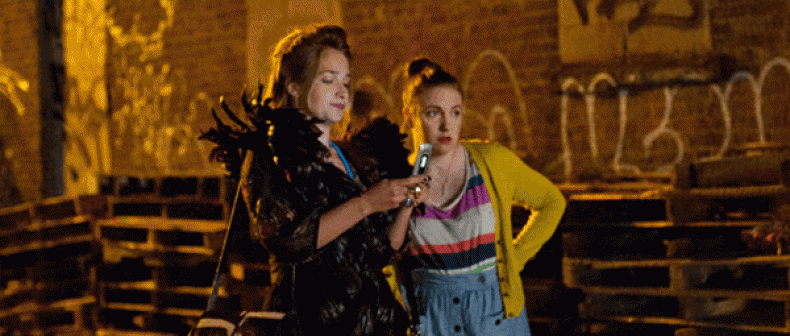
I wasn’t cool in high school. On Friday nights, I didn’t do what the ‘cool kids’ did, like drive around the San Fernando Valley and crash Bacchanalian house parties. (Admission: I may have picked up what the ‘cool kids’ did from movies.) On Friday nights I did what I did most nights–watch TV. For a period in the early 2000’s you could watch reruns of Absolutely Fabulous, a now completely forgotten female sketch comedy show called Smack the Pony, and Sex and the City. I dubbed the lineup ‘Women Behaving Badly.’ On second thought, who says I wasn’t cool?
I remember sneaking around my darkened house at midnight, paranoid that my parents would catch me watching such “mature subject matter.” But it wasn’t adult perversions that Sex and the City introduced me to. (Besides, I would’ve learned them soon enough during university.) Rather, Carrie Bradshaw and company instilled in me, along with an unshakeable habit for dirty double entendres, a life long love of fashion.
With the central four characters each embodying four distinct ways of dressing, the show was like a fashion magazine. Better than a fashion magazine, in fact, because the characters, unlike models, were women we had gotten to know and love. Although the later seasons got into shameless label-dropping, costume designer Patricia Field also worked in one-of-a-kind vintage pieces, creating trends as well as responding to them.
What made the show all the chicer was that the clothes were hardly ever mentioned: Carrie could wear a Vivienne Westwood headpiece resembling a pipe cleaner tiara, and everyone acted like nothing was out of the ordinary. Patricia Field never went for realism and fans liked it that way. The success of SATC led to a slew of imitators (the similar-named Cashmere Mafia and Lipstick Jungle) that rubbed couture-d shoulders with reality TV shows about models, designers and fashion magazines. The fashion industry even received the parody treatment with the soap opera comedy Ugly Betty. For the first time, women in stilettos were as common a sight on the small screen as doctors, lawyers, and cops.
Then TV’s love affair with fashion abruptly ended.
My initial concept for this post was a rundown of the TV shows, both new and returning, to watch this year for fashion. But choosing shows turned out to be a more difficult task than I had anticipated (Ed note: I banned Max from including Mad Men from the get-go. He promptly informed me that he “doesn’t even watch that show”).
Zooey Deschanel is a style icon (of sorts): she’s the best thing to happen for bangs since Bettie Page. While she wears many cute dresses as goofball Jess on New Girl, few are remembered after the commercial break. I’m looking forward to Mindy Kaling’s new show, but her character on The Mindy Project, unlike Kelly Kapur on The Office, doesn’r appear to be a clotheshorse. And as much as everyone loves Tina Fey and Amy Poehler, no one talks about dressing like Liz Lemon or Leslie Knope.
I’m not exactly holding my breath for the blasphemous Sex and the City prequel The Carrie Diaries.
Nighttime dramas have traditionally been fashionable (Dynasty inevitably comes up when discussing 1980’s style), but the current batch can’t hold a candle to Joan Collins. The clothes of Revenge appear to pick up where Gossip Girl left off. Perhaps it’s just me, but I don’t much care about how private school girls dress. I’m most disappointed in Nashville. You don’t have to be a country music fan to acknowledge that, back in the day, Loretta Lynn, June Carter and Dolly Parton had some kickass style. I see no sign of this big-hair-and-sequins legacy in the trailers for the new show.
Not surprisingly, when you ask people about their favourite TV shows for costume design, the names Mad Men, Boardwalk Empire, and Downton Abbey come up again and again. All three period pieces take place in eras when people still very much dressed up, and while the clothes are gorgeous, I wish viewers were being similarly inspired about contemporary fashions.
So what happened? One explanation is after the economic downturn TV producers felt nervous about shows celebrating opulence and materialism. We could laugh with Carrie Bradshaw spending all her money on shoes and saving nothing for an apartment (“I will literally be the old woman who lived in her shoe!”) before the financial crisis pushed many real people out of their homes. Networks have responded to changing times with more TV shows about middleclass families, like Modern Family, although so far nothing as vérité as working class Roseanne.
I have another theory. Fey, Poehler, and Kaling all write or produce their respective comedies, and they all feature protagonists with fulltime jobs for whom comfort is more important than style. “What I wear on the show is what I then steal and wear at home,” Tina Fey admitted to People magazine. It’s possible that female creators are a bit more conscious of being realistic about what working women wear, as well as not wanting their characters to be seen as superficial fashion plates.
Then, of course, there’s the female-created show about young women boldly titled Girls. Almost everyone has an opinion about Lena Dunham’s HBO program, even those who have yet to see an episode. While the clothes are often pretty and trendy, they mostly lean towards the vintage and vintage-inspired dresses that young women in Brooklyn actually wear. Although it’s the inheritor of Sex and the City in more ways than one, the only Girls‘ character who embodies the Patricia Field, ‘to heck with realism’ sentiment is Jemima Kirke’s Jessa. This is a character who wore a see-through, floor-length lace dress (with day-glow knickers) to her babysitting gig.
In an episode almost entirely set at a club, Jessa wears a top whose long black feathers giver her gladiator-sized shoulders. When you first see it you think, “What is she wearing?!” Then it grows on you. Eventually you see it as a perfect outfit for the character, one that shows her quirky-tough attitude and how she positions herself as an outsider.
Costume design shouldn’t just be fun assortments of clothes. Like a good TV show, it should challenge and inspire, and introduce a new way of seeing the world. Costumes are important, even when they’re feather-light.
____
Max Mosher writes about style for Toronto Standard. You can follow him on Twitter at @max_mosher_.
For more, follow us on Twitter @TorontoStandard or subscribe to our newsletter.














